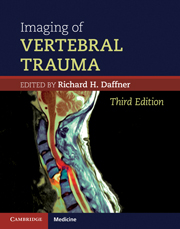Book contents
- Frontmatter
- Contents
- List of contributors
- Preface to the Third Edition
- Preface to the Second Edition
- Preface to the First Edition
- Acknowledgments
- 1 Overview of vertebral injuries
- 2 Anatomic considerations
- 3 Biomechanical considerations
- 4 Imaging of vertebral trauma I: indications and controversies
- 5 Imaging of vertebral trauma II: radiography, computed tomography, and myelography
- 6 Imaging of vertebral trauma III: magnetic resonance imaging
- 7 Mechanisms of injury and their “fingerprints”
- 8 Radiologic “footprints” of vertebral injury: the ABCS
- 9 Vertebral injuries in children
- 10 Vertebral stability and instability
- 11 Normal variants and pseudofractures
- Index
4 - Imaging of vertebral trauma I: indications and controversies
Published online by Cambridge University Press: 21 April 2011
- Frontmatter
- Contents
- List of contributors
- Preface to the Third Edition
- Preface to the Second Edition
- Preface to the First Edition
- Acknowledgments
- 1 Overview of vertebral injuries
- 2 Anatomic considerations
- 3 Biomechanical considerations
- 4 Imaging of vertebral trauma I: indications and controversies
- 5 Imaging of vertebral trauma II: radiography, computed tomography, and myelography
- 6 Imaging of vertebral trauma III: magnetic resonance imaging
- 7 Mechanisms of injury and their “fingerprints”
- 8 Radiologic “footprints” of vertebral injury: the ABCS
- 9 Vertebral injuries in children
- 10 Vertebral stability and instability
- 11 Normal variants and pseudofractures
- Index
Summary
The referring physician and the radiologist have many imaging techniques available for the diagnosis of the extent of vertebral injury. These include radiography, CT, MR imaging, and myelography. These techniques are used alone or in combination to arrive at the correct diagnosis. However, the imaging of patients with suspected vertebral trauma has also been one of the most controversial topics across many specialty lines since the mid-1990s [1,2]. This controversy has engendered a number of questions. Which patients need imaging? Are there certain clinical and historical factors that will identify those trauma patients who are at high or low risk for vertebral injury? If imaging is indicated, which modality should be used? Is there a role for radiography? Should CT be the method of choice? To answer these questions, a number of factors (ease of performance, efficacy of making a diagnosis, time required for the study, cost, and radiation exposure) that influence the selection of the appropriate imaging study must be examined.
This chapter will explore these issues, review the current concepts regarding selection of appropriate imaging studies, and will address the topic of “clearing” the spine in comatose patients. Detailed descriptions of the use of each of the established imaging formats will be described and illustrated in Chapters 5 and 6.
Indications
We live in an era in which the cost of health care is in the public spotlight daily.
- Type
- Chapter
- Information
- Imaging of Vertebral Trauma , pp. 45 - 52Publisher: Cambridge University PressPrint publication year: 2011



